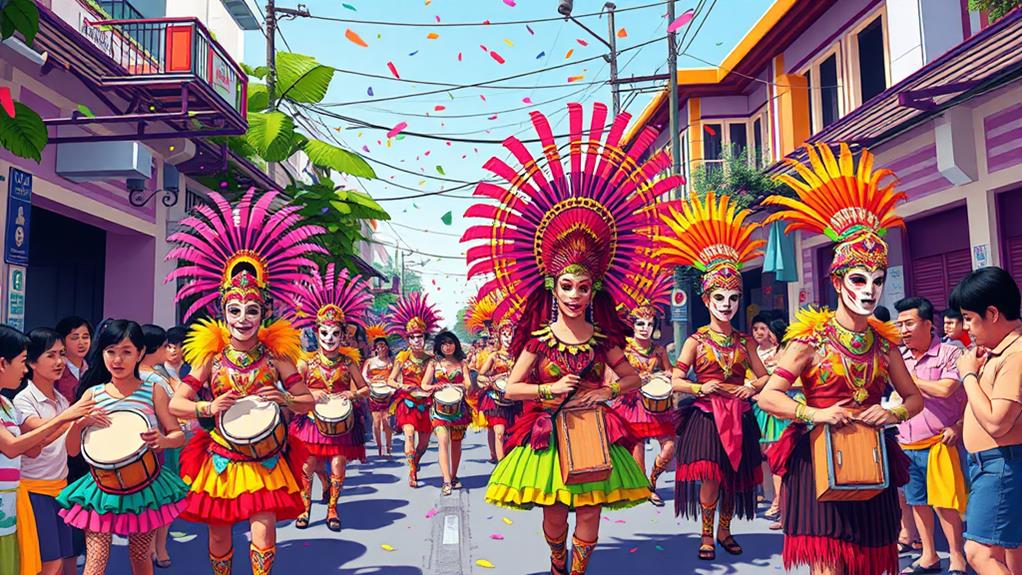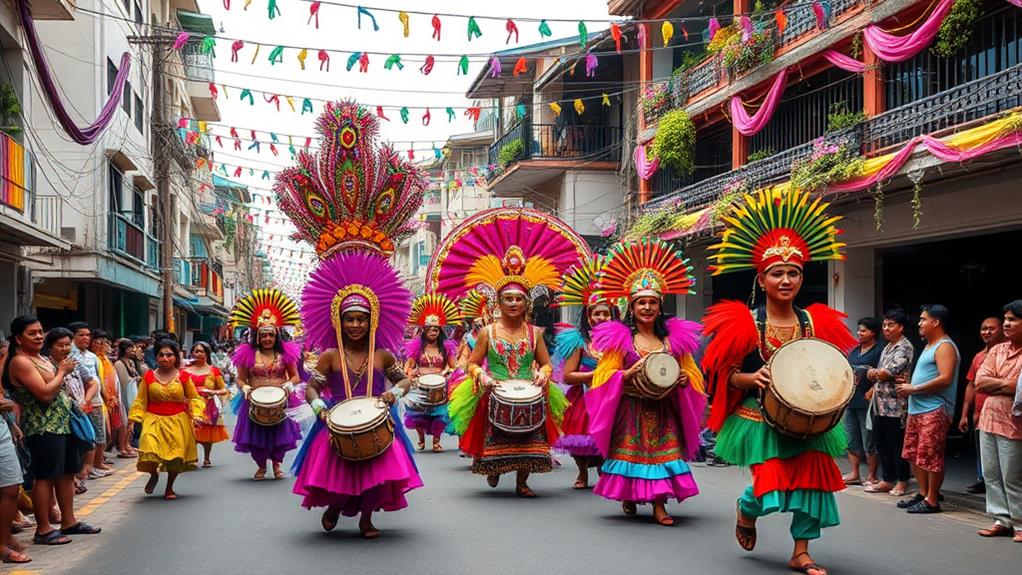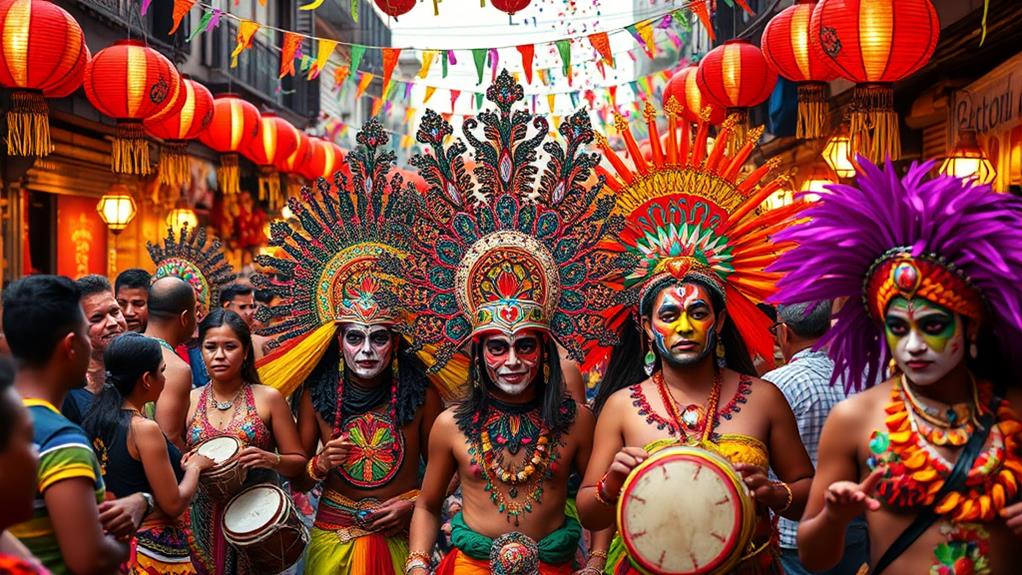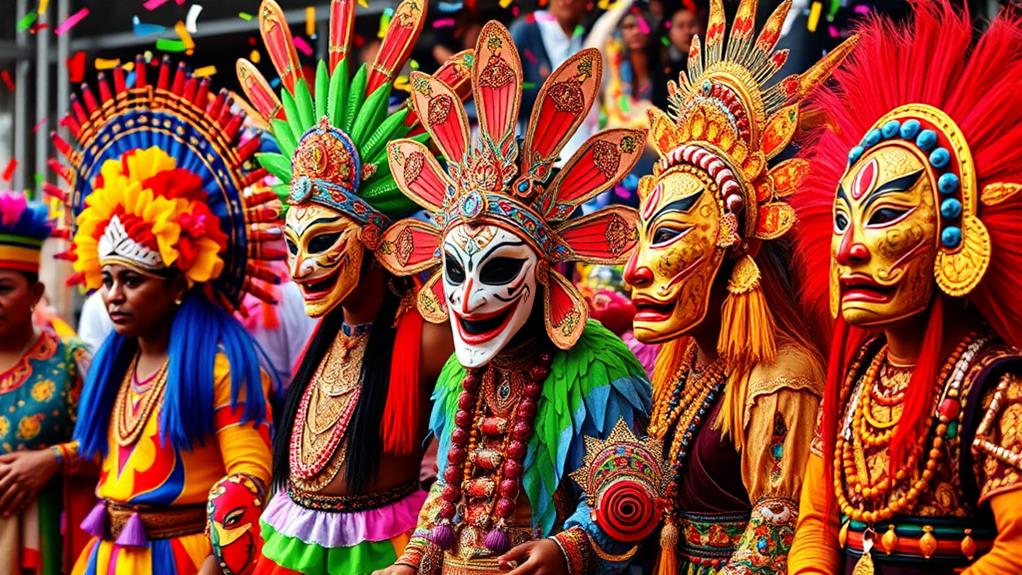The Ati-Atihan Festival: A Celebration of Cultural Heritage
The Ati-Atihan Festival is a vibrant celebration held in Kalibo, Aklan, that honors Santo Niño and the indigenous Ati people.
This festival blends pre-colonial and Catholic traditions in a unique cultural expression. Recognized by UNESCO as part of the Philippines' intangible cultural heritage, it symbolizes unity and respect for indigenous traditions.
The Festival's Vibrant Atmosphere
The streets of Kalibo come alive with lively street dancing, colorful costumes, and rhythmic drumbeats during the Ati-Atihan Festival.
These elements create an immersive experience that showcases the rich cultural heritage of the region.
Cultural Significance
The Ati-Atihan Festival is more than just a celebration; it's a symbol of unity and respect for indigenous traditions.
By blending pre-colonial and Catholic traditions, the festival promotes cultural understanding and appreciation.
Unveiling the Ati-Atihan Festival

The Ati-Atihan Festival: A Vibrant Celebration of Faith and Culture
The Ati-Atihan Festival is one of the most vibrant and culturally rich festivals in the Philippines, celebrated annually in Kalibo, Aklan. This festival honors Santo Niño (Infant Jesus) and the indigenous Ati people, showcasing a unique blend of faith and culture.
The Festival's Rich History
The Ati-Atihan Festival has its roots in the early 1200s, evolving from a local tradition to a vibrant cultural celebration.
Today, it features lively street dancing, colorful costumes, and rhythmic drumbeats.
A Symbol of Unity and Cultural Respect
During the festival, participants paint their faces black, paying homage to the Ati people.
This gesture symbolizes unity and cultural respect, rather than blackface.
A Series of Vibrant Events
The festival includes a series of events, such as a formal opening mass, processions, dance parades, and tribal competitions, culminating in a grand closing ceremony.
UNESCO Recognition
In 2012, the Ati-Atihan Festival was recognized by UNESCO as part of the Philippines' intangible cultural heritage.
This recognition showcases the country's rich traditions and community spirit.
Rich Cultural Heritage Revealed
Immerse in the Rich Cultural Heritage of the Ati-Atihan Festival
The Ati-Atihan Festival is a vibrant celebration of the Philippines' cultural diversity, showcasing the rich cultural heritage of the Ati people.
Cultural Elements
The festival combines indigenous customs, honoring the Ati people's traditions and way of life, with Catholic traditions, celebrating Santo Niño, a symbol of Catholic faith.
The festival also acknowledges the historical connection to the 1200s when Malay settlers arrived on Panay Island.
Cultural Expressions
The festival features vibrant street dancing, traditional music, and colorful costumes, promoting cultural expressions that unite communities and celebrate regional diversity.
A community mass also takes place, highlighting the importance of community bonding.
UNESCO Recognition
The Ati-Atihan Festival was recognized by UNESCO in 2012 as an integral part of the Philippines' intangible cultural heritage, showcasing the country's cultural diversity.
Vibrant Celebrations and Events

The Ati-Atihan Festival is a vibrant celebration that brings the rich cultural heritage of the Philippines to life.
The festival begins with a formal opening mass, followed by a grand procession where thousands of devotees carry images of Santo Niño. This highlights the festival's religious significance and showcases the community's devotion to the Sto. Niño.
Daily themed parades feature lively festivities, including snake dancing and vibrant performances at Magsaysay Park. These performances showcase the creativity and energy of the participants.
The highlight of the festival is the tribal competitions, which attract both local and tourist attention. Prizes are awarded for the best performances, encouraging participants to push their creativity and skills to the limit.
The festival's vibrant street dancing, colorful costumes, and rhythmic drumming fill the streets, creating an immersive atmosphere that invites community participation and interaction among attendees.
As the sun sets, the evening festivities come alive with music and entertainment, further enhancing the festive mood.
Exploring Ati-Atihan's Historical Roots
The Ati-Atihan Festival's Historical Roots
The Ati-Atihan Festival has a rich history that dates back to 1212 AD, when Malay chieftains from Borneo arrived on Panay Island and established a land agreement with the indigenous Ati people. This initial agreement marked the beginning of a cultural exchange between the two groups, which would eventually shape the festival's traditions.
Evolution of the Festival
Initially, the festival was a local tradition, but it evolved over the centuries, incorporating Christian elements introduced by Spanish colonizers in the 17th century.
The Spanish influence led to the celebration of the Santo Niño, a significant figure in Christian tradition.
Name and Significance
The festival's name "Ati-Atihan" means "to be like the Atis", reflecting the homage paid to the indigenous Ati people through cultural practices and face painting.
This unique blend of cultural influences has contributed to the Ati-Atihan Festival's significance, now recognized as part of the Philippine intangible cultural heritage.
Festival Experience and Atmosphere

Immerse yourself in the vibrant atmosphere of the Ati-Atihan Festival, where rhythmic drumbeats and lively street festivities create an electrifying experience. The festival's engaging atmosphere is a perfect blend of joy, energy, and cultural homage.
Daily themed parades are a key aspect of the festival's infectious energy. Over 80 performing groups take to the streets, showcasing elaborate costumes and rhythmic drumbeats that amplify the festival's lively ambiance.
These parades feature a kaleidoscope of colors, sounds, and movements that draw you in.
Traditional face paint is another significant element of the festival. Participants don dark face paint to emulate the Ati people, paying cultural homage and adding to the festive spirit.
This unique tradition allows festival-goers to connect with the rich cultural heritage of the Ati people.
Unique dance routines are a major highlight of the festival. Tribes compete with intense passion, displaying their one-of-a-kind dance routines and costumes that captivate the audience.
These performances showcase the rich cultural diversity of the region and leave a lasting impression on the spectators.
Evening events provide the perfect opportunity to fully immerse yourself in the rich cultural experience. Live music and interactive performances create an electrifying atmosphere that complements the festival's vibrant street festivities.
Throughout the festival, you'll find yourself swept up in the vibrant street festivities, surrounded by the rhythmic drumbeats, elaborate costumes, and infectious energy of the Ati-Atihan Festival.
Cultural Significance and Impact
The Ati-Atihan Festival holds profound cultural significance for the Filipino people. It honors the indigenous Ati people and the Santo Niño, symbolizing the harmonious integration of pre-colonial traditions and Catholic beliefs in Filipino culture.
By painting their faces black, participants show respect and dedication to preserving the festival's roots. This tradition demonstrates cultural respect for the Ati people.
The festival's vibrant street dancing, colorful costumes, and traditional music express Filipino identity. These expressions promote awareness and appreciation of regional diversity in the Philippines.
The Ati-Atihan Festival is a significant event in Philippine intangible cultural heritage, recognized by UNESCO in 2012. It plays a vital role in preserving and promoting local culture and traditions.
Through this festival, visitors experience the rich cultural heritage of the Aklan region and the unity it fosters among locals and participants.
How Does Ati-Atihan Festival Showcase the Cultural Diversity of the Philippines?
The Ati-Atihan Festival is a vibrant celebration that showcases the cultural diversity of the Philippines. This event features colorful costumes, traditional music, and lively dances that highlight the rich heritage of the different regions in the country. It is a testament to the evolution of philippine democracy and the freedom to express cultural identity.
Beyond Kalibo: Similar Festivals

Beyond Kalibo: Similar Festivals
Regional Variations of the Ati-Atihan Festival
Aside from Kalibo, several towns in Aklan observe their own versions of the Ati-Atihan Festival, each infused with unique local flavors and traditions.
Ibajay, Lezo, Malinao, Makato, Batan, Altavas, and Malay (Boracay) all celebrate the festival in their own way, reflecting their distinct cultural identities.
Similar Festivals in Nearby Provinces
Beyond Aklan, similar festivals can be found in nearby towns in Antique and Capiz, contributing to a vibrant regional celebration of culture and community.
Dinagyang in Iloilo shares similar themes of gratitude and community, reflecting the widespread cultural significance of the Santo Niño and indigenous heritage.
Halaran in Capiz highlights local culture through unique customs, music, and dance, while Binirayan in Antique emphasizes the preservation of Philippine cultural heritage.
Other regional festivals collectively promote regional tourism and celebrate the rich cultural heritage of the region.
Cultural Significance and Preservation
These festivals not only showcase the rich cultural diversity of the region but also contribute to the preservation of Philippine cultural heritage, making them a must-visit for anyone interested in experiencing the authentic spirit of the Ati-Atihan Festival.
Frequently Asked Questions
What Is the Ati-Atihan Festival Celebrated For?
The Ati-Atihan Festival celebrates the arrival of Malay settlers on Panay Island and their integration with the indigenous Ati people.
This significant event in history is commemorated through a vibrant cultural heritage festival.
The festival showcases traditional costumes, dance rituals, and music influences, highlighting community involvement and cultural preservation.
Who Won the Ati-Atihan Festival in 2024?
The winners of the Ati-Atihan Festival in 2024 were announced during the grand closing ceremony.
The top three contingents were awarded for their stunning costume designs and captivating dance performances.
The first place winner was the Kalibo Dance Company, followed by the Aklan Performing Arts Group in second place, and the Boracay Cultural Troupe in third place.
These contingents showcased a perfect blend of traditional and modern dance performances, highlighting the cultural significance of the event.
What Is the Culture Behind the Ati-Atihan Festival in Kalibo Aklan?
The Ati-Atihan Festival has its roots in the 1200s.
This celebration honors the indigenous Ati people and showcases their influences on the culture.
The festival's cultural significance is reflected in its vibrant traditional costumes, festival rituals, and mesmerizing music and dance performances. These artistic expressions are a testament to the community's involvement and historical background.
The local cuisine and joyful atmosphere also play a significant role in this unique cultural heritage.
The festival's origins date back to the 1200s, when the Ati people, the indigenous inhabitants of the island of Panay, welcomed the arrival of Malay settlers.
This cultural exchange is still celebrated today through the festival's rituals and performances.
Is the Ati-Atihan Festival Religious or Non Religious?
The Ati-Atihan Festival is both religious and non-religious. This multifaceted celebration has spiritual significance and historical origins, but it also honors cultural heritage and indigenous roots.
On one hand, the festival has religious elements, such as rituals and processions, which reflect its spiritual significance. These practices are rooted in the region's historical origins and local beliefs.
On the other hand, the festival also involves community involvement and festive traditions, which are non-religious in nature. These aspects of the celebration focus on cultural expression and community bonding.
Ultimately, the Ati-Atihan Festival is a unique blend of local beliefs, symbolism, and cultural expression, making it both religious and non-religious.